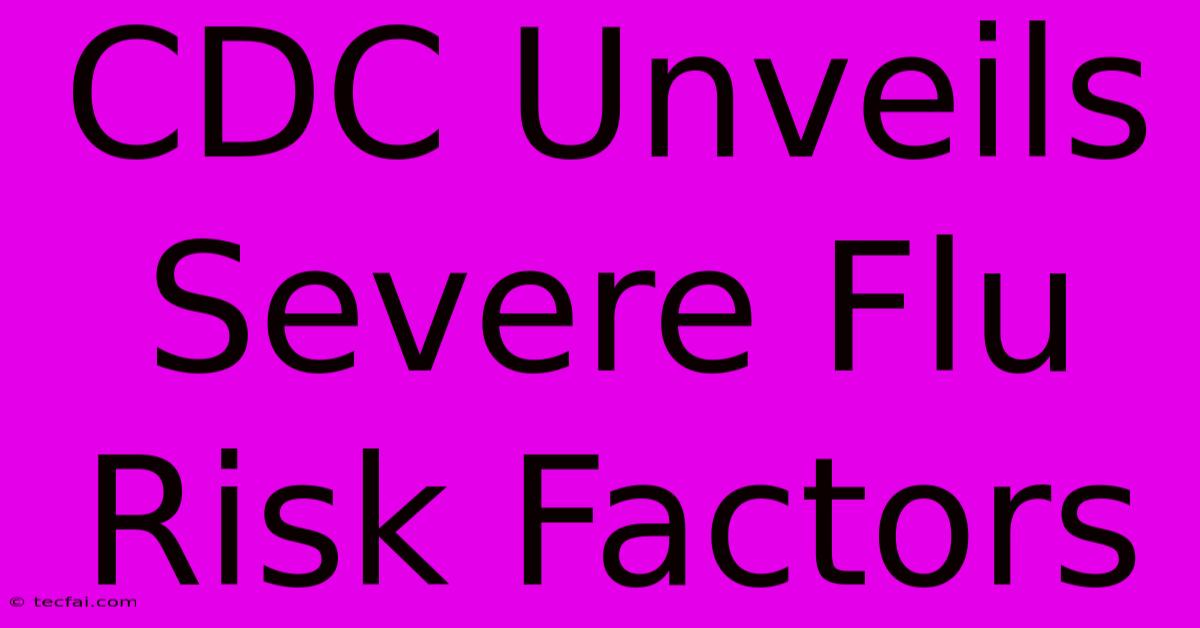CDC Unveils Severe Flu Risk Factors

Discover more detailed and exciting information on our website. Click the link below to start your adventure: Visit Best Website tecfai.com. Don't miss out!
Table of Contents
CDC Unveils Severe Flu Risk Factors: Who's Most Vulnerable This Season?
The Centers for Disease Control and Prevention (CDC) has released updated information highlighting the individuals at highest risk of developing severe influenza (flu) complications this season. Understanding these risk factors is crucial for proactive prevention and early intervention, potentially saving lives and minimizing the impact of the flu. This article delves into the CDC's findings, explaining who is most vulnerable and what steps can be taken to mitigate the risk.
Understanding the Severity of the Flu
Before diving into the risk factors, it's important to remember that the flu is not just a common cold. While many experience mild symptoms, the virus can lead to severe complications, particularly in vulnerable populations. These complications can include pneumonia, bronchitis, ear infections, sinus infections, and even death. The severity of the illness can vary greatly depending on individual health and circumstances.
Key Risk Factors Identified by the CDC
The CDC emphasizes several key risk factors that significantly increase the likelihood of developing severe flu:
Age: Young Children and Older Adults
- Young Children (under 5 years old): Their immune systems are still developing, making them less equipped to fight off the flu virus. Infants and toddlers are at particularly high risk.
- Older Adults (65 years and older): As we age, our immune systems weaken, making us more susceptible to infections and less able to effectively combat the virus. Existing health conditions often exacerbate this vulnerability.
Underlying Medical Conditions
Individuals with certain chronic health conditions are significantly more vulnerable to severe flu complications. These include:
- Chronic Lung Conditions: Asthma, COPD (chronic obstructive pulmonary disease), cystic fibrosis.
- Heart Conditions: Congestive heart failure, coronary artery disease.
- Weakened Immune Systems: HIV/AIDS, cancer, autoimmune disorders, individuals undergoing organ transplantation, or those receiving immunosuppressive therapies.
- Metabolic Conditions: Diabetes, obesity.
- Kidney Disease: Chronic kidney disease.
- Liver Disease: Chronic liver disease.
- Blood Disorders: Sickle cell disease, thalassemia.
- Neurological Conditions: Cerebral palsy, epilepsy.
Pregnancy
Pregnant individuals are at increased risk of severe flu complications, including pneumonia and the need for hospitalization. The changes in their immune system and respiratory function during pregnancy contribute to this heightened vulnerability.
Race and Ethnicity
Certain racial and ethnic minority groups experience a disproportionately higher burden of severe flu illness. Social determinants of health, access to healthcare, and underlying health disparities play a significant role in this disparity. Further research is ongoing to better understand these complex interactions.
Protecting Yourself and Others: Prevention is Key
Given the severity of the flu and the heightened risk for specific populations, proactive prevention is paramount. The CDC recommends the following measures:
Vaccination
- Annual Flu Vaccination: The single most effective way to protect yourself and others from the flu is by getting an annual flu vaccine. It's particularly crucial for individuals in high-risk groups.
- Timing: The best time to get vaccinated is in the fall, before flu season begins.
Hygiene Practices
- Frequent Handwashing: Wash your hands frequently with soap and water for at least 20 seconds.
- Covering Coughs and Sneezes: Cover your mouth and nose with a tissue or your elbow when you cough or sneeze.
- Avoiding Touching Your Face: Avoid touching your eyes, nose, and mouth.
Staying Home When Sick
- Rest and Recovery: If you are sick, stay home from work or school to avoid spreading the virus.
Seeking Medical Attention
If you experience flu-like symptoms such as fever, cough, sore throat, muscle aches, and fatigue, it's crucial to contact your healthcare provider, especially if you are in a high-risk group. Early treatment can significantly reduce the severity of the illness and prevent complications.
The CDC's guidance on severe flu risk factors serves as a critical reminder of the importance of prevention and early intervention. By understanding these factors and taking proactive measures, we can collectively mitigate the impact of the flu and protect the most vulnerable members of our communities. Remember to consult with your doctor for personalized advice and recommendations.

Thank you for visiting our website wich cover about CDC Unveils Severe Flu Risk Factors. We hope the information provided has been useful to you. Feel free to contact us if you have any questions or need further assistance. See you next time and dont miss to bookmark.
Featured Posts
-
Bayern Needs Ucl Wins To Advance
Nov 26, 2024
-
Cctv Shows Tractor In Tenbury Wells Flood
Nov 26, 2024
-
Microsoft 365 Outage Users Report Issues
Nov 26, 2024
-
Israel Under Hezbollah Rocket Fire
Nov 26, 2024
-
Mc Conkey Playing This Week
Nov 26, 2024
